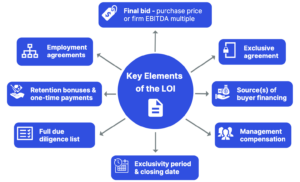
Small Business Exits: M&A closed deal data from June
Welcome to the June edition of Small Business Exits, the monthly publication featuring fully anonymized deal data from a selection…
The letter of intent is a more formal document than the IOI, and outlines a final price and deal structure that a buyer puts forward for a target company. Unlike the IOI, which offers a general price range, the LOI provides a specific bid for the company that reflects the price they are proposing to pay.
The LOI indicates that the buyer would like to work exclusively with the target company for a defined period (usually 60-120 days). During this time, buyers conduct a full due diligence process, while continuing to have meetings with the company’s management team to better understand the business. If, as the seller, you accept and execute the LOI, it prohibits you from speaking with other buyers. This differs from an IOI, which does not correspond with any exclusivity requirement.
A buyer doesn’t necessarily need to issue an IOI before an LOI. Some sellers obtain IOIs first, while others go straight to the LOI stage.
Normally, an LOI comes after one to three meetings with a prospective buyer. If you are running a structured sale process soliciting bids from multiple buyers, it’s likely that you will have narrowed the pool to less than five prospective buyers for these more in-depth discussions.
If both the business owner and the prospective buyer(s) are interested in continuing the M&A process, the buyer(s) should submit a letter of intent (LOI) outlining the buyer’s proposed deal structure and terms. Receipt of an LOI from a potential buyer is a clear signal that they are serious in their intentions; however, it is not a given that they are fully committed yet. Some buyers try to lock up as many deals as possible, but only close the top three to four.

The LOI typically includes a summary description of all of the material deal terms that will later appear in the purchase agreement. There are differing schools of thought regarding how detailed an LOI should be; the document can range from two to over ten pages in length. Some argue shorter LOIs speed up the negotiating process since the parties focus their conversations on the primary terms: price, consideration, and timing. If the parties can’t agree on these fundamentals, the logic goes, there’s no need to even get into other deal terms. Those in favor of longer LOIs prefer to have all issues addressed upfront and prevent any future surprises (e.g., reps and warranties or treatment of unvested options).
OTHER TERMS THAT MIGHT APPEAR IN AN LOI
While the LOI is not binding and the transaction terms will be finalized only in the purchase agreement, it is best practice to include all critical terms in the LOI. Inserting terms into the purchase agreement that were not included in the signed LOI is not uncommon, but it can come at a price.
For example, if you have employees who do not hold equity but you want them to receive a payment at closing or an extended employment contract, that should be in the signed LOI. If you have issues that may impact valuation or a buyer’s decision to close the transaction (e.g., unresolved equity disputes or litigation), it is best to disclose these issues prior to signing the LOI. It’s better to get in front of these issues in the LOI stage than to have them discovered in due diligence. If you’re curious about some of the reasons behind why deals die, check out Axial’s inaugural Dead Deals and Broken LOIs report, published this past February.
The LOI is an important milestone in the successful sale of a company. If you have not engaged an M&A attorney yet, now is the time to add one to your deal team. Similarly, you should consult with your tax accountant and wealth manager regarding the ideal deal structure before signing the agreement. Professional investment bankers can also help make sure you receive the best deal.
This is the final piece within our Exit Ready Document Series. If you missed any, feel free to access them below or download our 7 M&A Documents Demystified Ebook:
NOTE: This information does not, and is not intended to, constitute legal advice; instead, all information, content, and materials available on this site are for general informational purposes only.
